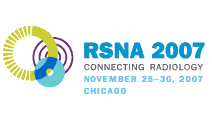
Abstract Archives of the RSNA, 2007
SSA01-02
Cancers Not Detected at MR Imaging: Review of False-Negative Lesions
Scientific Papers
Presented on November 25, 2007
Presented as part of SSA01: Breast Imaging (MR Imaging)
Akiko Shimauchi MD, Presenter: Nothing to Disclose
Sanaz A. Jansen, Abstract Co-Author: Nothing to Disclose
Hiroyuki Abe MD, Abstract Co-Author: Research grant, Totoku Electric Co, Ltd
Kirti Manohar Kulkarni, Abstract Co-Author: Nothing to Disclose
Robert Albert Schmidt MD, Abstract Co-Author: Minor stockholder, Hologic/R2 Technology, Inc, Los Altos, CA
Research grant, Fuji Photo Film Co, Ltd, Stamford, CT
Research Grant, Konica Minolta
Consultant, Konica Minolta
Advisory Board, Konica Minolta
Spouse: Philips research grants
Spouse: Berlex, speaker's bureau
Gillian Maclaine Newstead MD, Abstract Co-Author: Research support, Fuji Photo Film Co, Ltd
Advisory Board, Konica Minolta Group
Advisory Board, Koninklijke Philips Electronics
Research support, Bayer AG
Speakers Bureau, Bayer AG
Spouse, stockholder, Hologic, Inc
Shital Saurin Makim MBBS, Abstract Co-Author: Nothing to Disclose
Charlene A. Sennett MD, Abstract Co-Author: Nothing to Disclose
et al, Abstract Co-Author: Nothing to Disclose
et al, Abstract Co-Author: Nothing to Disclose
To evaluate the sensitivity of dynamic contrast enhanced magnetic resonance imaging (DCEMRI) in a cohort of patients with newly diagnosed breast cancer and to evaluate the characteristics of lesions with false-negative MRI examinations.
IRB approved retrospective review of 857 consecutive breast MRI examinations between 1/3/06 and 2/27/07, yielded 195 newly diagnosed cancers in 192 patients (22.4%) referred for MRI staging. All patients had received percutaneous biopsy of the index lesion prior to MR imaging. Patients were evaluated with parallel imaging using fat suppression techniques. Breast MRI examinations were reviewed by 2 experienced readers, and all lesion histology was reviewed by an experienced breast pathologist.
Of the 195 cancer lesions, enhancement was observed in 186 cases (95.4%). The sensitivity of MRI for the diagnosed cancers was 79.4% (27/34) for DCIS, and 98.8%(164/166) for invasive cancer. There were 9 cancers (4.6%) that showed no enhancement on MRI. The 9 non-enhancing cancers included 7 cases of ductal carcinoma in situ (DCIS), 3 low-grade, 1 intermediate-grade, 2 high-grade (grade was not available for 1 lesion), and 2 cases of invasive ductal carcinoma, both intermediate-grade. All non-enhancing cancers were visualized on either mammogram or ultrasound before MRI, and the median pre-biopsy size of the false-negative cancers was 10 mm (range 5-65 mm). 7 lesions were measured at mammogram, 1 lesion was measured at ultrasound, and 1 lesion was partly obscured. Of the false-negative lesions, 4 were not detected even retrospectively, likely because of their small size. Of the remaining 4 lesions, 3 were DCIS and 1 was predominantly DCIS with associated invasion. These 4 lesions were inconspicuous at MRI likely because their non-mass-like morphology was obscured by intensely enhancing parenchyma.
MRI offers a very high sensitivity for diagnosis of both invasive cancer and DCIS. Reasons for false-negative examinations (4.6%) were small size and perception problems due to masking of the lesion by intensely enhancing parenchyma.
Recognition that certain cancers may not visible at MRI, should allow for more accurate diagnosis for selected cases.
Shimauchi, A,
Jansen, S,
Abe, H,
Kulkarni, K,
Schmidt, R,
Newstead, G,
Makim, S,
Sennett, C,
et al, ,
et al, ,
Cancers Not Detected at MR Imaging: Review of False-Negative Lesions. Radiological Society of North America 2007 Scientific Assembly and Annual Meeting, November 25 - November 30, 2007 ,Chicago IL.
http://archive.rsna.org/2007/5004825.html

